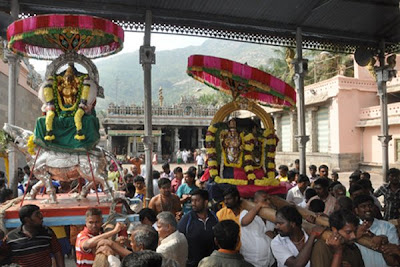Significance of Pradosham
Pradosham is a significant day to worship Lord Siva and his consort Goddess Parvati. It falls on the the 13th day (Trayodasi) of the lunar cycle and hence falls two times in a month, once in the waxing period and once in the waning period. Pradosham is joyously and elaborately celebrated at Arunachaleswarar Temple. The date of the most recent celebration was October 13 and below are series of photographs of that day.
History of Pradosham
One time the Devas and Asuras used the serpent Vasuki and the hill Mandhara to try and get Amrutham (nectar) from the Kseerabthi (milk ocean). Their churning made the poison Halahala emerge. In answer to their prayers Lord Shiva came to their rescue and drank the poison and ordered the Devas to resume their churning of the ocean. On the twelfth moon day (Dwadhasi) the Devas were finally able to get the Amrutham.
In celebration they danced and sang but forgot to thank God. On the thirteenth moon day (Trayodhasi) the Devas realised their sin and prayed to Lord Shiva for forgiveness.
Pleased, Lord Shiva forgave the Devas and danced between the horns of his bull Nandi. That time is called Pradosham and it is believed that if one prays to Lord Shiva at that time, ones’ wishes will be fulfilled one will be given mukti.
During Pradosham time anointing (Abhishekam) the Shiva deity with the following is considered fruitful:
Offering Milk (for long life)
Offering Ghee (for Moksha)
Offering Curd (for good children)
Offering Honey (for a melodious voice)
Offering Rice powder (relief from debt)
Offering Sugar cane juice (for good health)
Offering Panjamrutham (gives wealth)
Offering Tender coconut (to acquire enjoyment)
Offering Cooked Rice (to achieve a majestic life)
Offering Sandal (to acquire Lakshmi's Grace)
Offering of Lemon (removes fear of death)
Offering
Sugar (removes enmity and bad relationships).
[Pradosham Purana]
Photographs of Pradosham, Arunachaleswarar Temple,
October 13, 2012
Periods of Pradosham
Waxing Period is the 15 days after Amavasaya or the New Moon Day.
Waning period is the 15 days after Poornima or the Full Moon Day.
Pradosham in the waxing period of the moon is supposed to be more significant. Moreover if Pradosham falls on a Monday it is called Somavara Pradosham and is highly auspicious. Pradosham which falls on a Saturday is called Sani Pradosham and that is also very important.
If one cannot observe a fast on all Pradosham, at least Somavar Pradosham, Sanivar Pradosham and the ones in the waxing period should be observed for pleasing the Lord.
The evening of travodasi, i.e., the 13th moon day between 4.30 p.m., and 6.00 p.m. is Pradosham. It is believed that whatever sins we have committed will be forgiven by the Lord if we pray wholeheartedly.
Pradosham timings are 1.5 hours before sunset and 1 hour after sunset, that is it is observed in the twilight period. Some do Abishekam for the Lingam, some people chant "OM Nama Shivaya", some chant the Maha Mrityunjaya Mantra (given below) 108 times and the very pious also read the Siva Skanda Purana Story. But it is said, that just lighting a lamp and praying also please the Lord a lot.
The Maha Mrityunjaya Mantra and its meaning:
Om Tryamlakam Yajamahe
Sugandhim Pustivardhanam
Urva rukamiva Bandhanan
Mrtyor muksheeya Ma amritat
Om. We worship The Three-Eyed Lord Shiva who is fragrant and who increasingly nourishes the devotees. By worshipping him may we be liberated from death for the sake of immortality just as the ripe cucumber easily separates itself from the binding stalk.












.jpg)

.jpg)




